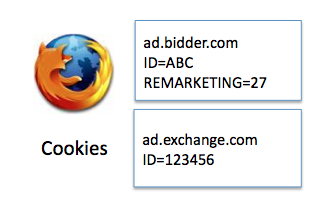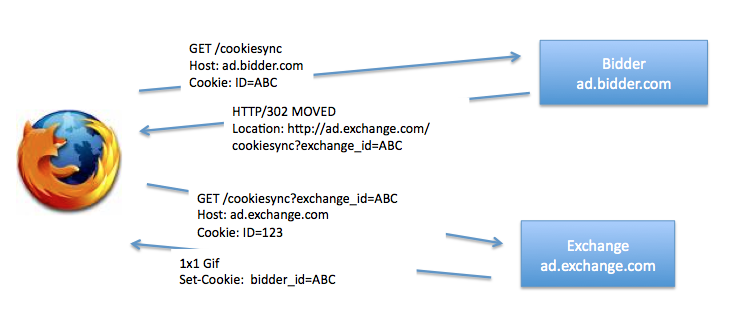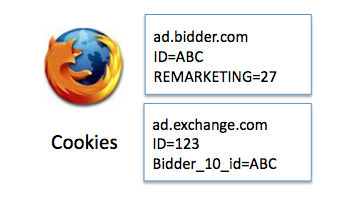Cookie Matching.
A number of people have asked about how cookie matching works in the RTB world. Everybody today relies on cookies to store information about a user — which ads he’s seen, what sites he’s been to, which behavioral segment he’s in — all the good stuff. Without cookies, we can’t frequency cap, we can’t remarket, we can’t track, basically, advertising becomes pretty useless!
Now the way browsers work, cookies are tied to a domain. Say an ad-exchange has ad tags on a page under ‘ad.exchange.com’. When a browser requests an ad from the exchange, it only passes along the cookie data that’s stored inside that domain name. This means that the exchange has zero insight into whatever data the bidder might have collected under ad.bidder.com.
So why is this a problem? Well, if the exchange is going to do a server-side bid request to the bidder, it’s pretty hard for the bidder to make a decision about what ad to serve if it has no access to either frequency or behavioral data!
An Example. Bidder is running a behavioral campaign for marketer “marketer.com”. Bidder has a pixel on the marketer’s site, it’s internal ID for the pixel is 27. Each time this pixel fires the bidder ads a cookie to it’s domain ‘ad.bidder.com’, ‘segment=27′. The bidder now wants to buy as much inventory as possible for this remarketing segment across exchanges. Bidder has a user-id, ‘ABC’ for this cookie.

Exchange, ‘exchange.com’ wants the bidder to be able to buy as much inventory as possible. Hence the exchange wants the bidder to be able to use all remarketing segments to buy. Problem is (as mentioned above), they’re using separate cookie domains. So what needs to happen is that the exchange and the bidder need to synchronize their domains so that when the bidder receives a real time bid request he can look-up the information associated with that user.
Fundamentally the logic for synchronizing IDs is pretty simple. The exchange drops a pixel on a page somewhere which points to a bidder’s domain and a simple usersync call. When the call hits the bidder, it reads in it’s cookie ID, redirects off to the exchange passing it’s ID in the querystring so that the exchange can read and store it into it’s cookie space.

The above diagram shows this process. First a pixel is dropped that hits the bidder domain. The bidder receives this call and reads in it’s cookie ID of ‘ABC’. Bidder then redirects the user to get a request from the exchange under ad.exchange.com, passing in the id ‘ABC’ in the querystring. The exchange now receives a call, reads in from the cookie that his ID is 123, and can now map that his user 123 maps to bidder’s user ABC.

Now user IDs are synchronized, the exchange and the bidder can talk about a single user in the same manner. Note that in the above example I noted that the exchange is storing the ID for the bidder. Admeld, PubMatic & the like all work like this. Google does it slightly differently and instead requires the bidder to store the mapping on his end — effectively just the reverse of the above process.
No comments:
Post a Comment